Optimization Design of Dynamic Cable Configuration Considering Thermo-Mechanical Coupling Effects
Abstract
1. Introduction
2. Coupling Analysis Model of Floating Wind Turbine
2.1. OC3-Hywind Floating Wind Turbine
2.2. Marine Environmental Loading
2.3. Dynamic Cable
2.3.1. Global Configuration Design
2.3.2. Equivalent Stiffness Calculation
3. Dynamic Cable Configuration Optimization Model
3.1. Optimization Parameters and Objectives
3.2. Optimal Latin Hypercube Sampling (OLHS)
3.3. RBF Surrogate Model
3.4. NSGA-II Optimization Algorithm
- (1)
- The Optimal Latin Hypercube Sampling (OLHS) method is used to generate a sufficient number of sample points that are uniformly distributed in the design space, ensuring comprehensive coverage of the key design variable ranges. To avoid issues such as touchdown of the hanging segment or excessive arching of the buoyant segment in the static configuration of the dynamic cable, initial screening is conducted to filter out inappropriate configurations, thereby improving computational efficiency. Based on the filtered samples, extreme responses under two working conditions—maximum effective tension and maximum bending curvature—are calculated using time-domain models of the dynamic cable under different stiffness conditions.
- (2)
- Based on the sampled data, a Radial Basis Function (RBF) neural network is used to construct a surrogate model that captures the nonlinear relationships between key design variables and response indicators. The prediction accuracy of the surrogate model is evaluated through error analysis, ensuring that the error between the model predictions and validation samples is minimized, thereby enhancing the model’s accuracy and reliability.
- (3)
- Using the nonlinear relationships established by the RBF surrogate model, the NSGA-II algorithm is applied to search for the Pareto-optimal front within the design variable space, achieving multi-objective optimization of cable tension and curvature. This ensures that multiple objectives are optimized simultaneously under different design variable combinations, providing a scientific basis for evaluating and selecting design solutions. The specific steps of the optimization process are illustrated in Figure 9.
4. Discussion of Optimization Results
4.1. Effective Tension
4.2. Bending Curvature
4.3. Fatigue Life
5. Conclusions
- (1)
- The maximum deviation between the single-objective optimization results and numerical simulations is 6.15%, verifying the feasibility and accuracy of the proposed optimization model.
- (2)
- Compared to the initial design, the optimized configurations based on mechanical and thermo-mechanical coupling analyses achieved reductions in effective tension by 4.93% and 2.59%, respectively, and reductions in curvature by 7.39% and 9.42%, respectively.
- (3)
- While the total length of the dynamic cable was slightly reduced, its global dynamic response was significantly improved, and its fatigue life was markedly enhanced, with improvements of 13.04% and 20.24%, respectively, relative to the initial design. Notably, the optimization based on thermo-mechanical coupling demonstrated superior performance, offering a new perspective for dynamic cable configuration optimization.
Author Contributions
Funding
Data Availability Statement
Conflicts of Interest
References
- Taninoki, R.; Abe, K.; Sukegawa, T.; Azuma, D.; Nishikawa, M. Dynamic cable system for floating offshore wind power generation. SEI Tech. Rev. 2017, 146, 53–58. [Google Scholar]
- Yan, J.; Hu, H.; Su, Q.; Yin, Y.; Wu, S.; Lu, H.; Lu, Q. Prospect and progression of key mechanical problems in marine cables. Chin. J. Theor. Appl. Mech. 2022, 54, 846–861. [Google Scholar]
- Fang, P.; Jiang, X.; Hopman, H.; Bai, Y. Mechanical responses of submarine power cables subject to axisymmetric loadings. Ocean. Eng. 2021, 239, 109847. [Google Scholar] [CrossRef]
- Li, X.; Liu, Z.; Jiang, X.; Hopman, H. RVE model development for bending analysis of three-core submarine power cables with dashpot-enhanced periodic boundary conditions. Ocean. Eng. 2024, 309, 118588. [Google Scholar] [CrossRef]
- Qiao, D.; Zou, G.; Chen, H.; Tang, G.; Lu, L.; Ou, J. Influence of thermo-mechanical coupling effects on the stiffness characteristics of dynamic cables. Appl. Ocean. Res. 2025, 158, 104583. [Google Scholar] [CrossRef]
- Liu, H.; Guo, L.; Chen, Z.; Meng, Y.; Zhang, Y. Study on bonding mechanism of hot-cast anchorage of Galfan-coated steel cables. Eng. Struct. 2021, 246, 112980. [Google Scholar] [CrossRef]
- Yan, J.; Bu, Y.; Su, Q.; Chen, J.; Lu, Z.; Jin, C.; Lu, Q. Multiphysics coupling analysis of dynamic cable cross section for floating wind turbine. Appl. Sci. Technol. 2022, 49, 19–25. [Google Scholar]
- Guarize, R.; Matos, N.A.F.; Sagrilo, L.V.S.; Lima, E.C.P. Neural networks in the dynamic response analysis of slender marine structures. Appl. Ocean. Res. 2007, 29, 191–198. [Google Scholar] [CrossRef]
- Chen, J.; Yan, J.; Yang, Z.; Yue, Q.; Tang, M. Flexible riser configuration design for extremely shallow water with surrogate-model-based optimization. J. Offshore Mech. Arctic Eng. 2016, 138, 041701. [Google Scholar] [CrossRef]
- Yang, Z.; Yan, J.; Sævik, S.; Lu, Q.; Ye, N.; Chen, J.; Yue, Q. Integrated optimization design of a dynamic umbilical based on an approximate model. Mar. Struct. 2021, 78, 102995. [Google Scholar] [CrossRef]
- Rentschler, M.; Adam, F.; Chainho, P. Design optimization of dynamic inter-array cable systems for floating offshore wind turbines. Renew. Sustain. Energy Rev. 2019, 111, 622–635. [Google Scholar] [CrossRef]
- Schnepf, A.; Giljarhus, K.E.T.; Johnsen, Ø.; Lopez-Pavon, C. Dynamic power cable configuration design for floating offshore wind turbines using gradient-based optimization. In Proceedings of the ASME 2023 42nd International Conference on Ocean, Offshore and Arctic Engineering, Melbourne, Australia, 11–16 June 2023. [Google Scholar]
- Ahmad, I.; Schnepf, A.; Ong, M. An optimisation methodology for suspended inter-array power cable configurations between two floating offshore wind turbines. Ocean. Eng. 2023, 278, 114406. [Google Scholar] [CrossRef]
- Schnepf, A.; Devulder, A.; Johnsen, Ø.; Ong, M.; Lopez-Pavon, C. Numerical investigations on suspended power cable configurations for floating offshore wind turbines in deep water powering an FPSO. J. Offshore Mech. Arctic Eng. 2023, 145, 030904. [Google Scholar] [CrossRef]
- Beier, D.; Janocha, M.; Ye, N.; Ong, M. Fatigue assessment of suspended inter-array power cables for floating offshore wind turbines. Eng. Struct. 2024, 308, 118007. [Google Scholar] [CrossRef]
- Orcina Ltd. OrcaFlex User Manual; Orcina Ltd.: Ulverston, UK, 2022; Available online: https://www.orcina.com/webhelp/OrcaFlex/ (accessed on 19 January 2025).
- Jonkman, J.; Musial, W. Offshore code comparison collaboration (OC3) for IEA Wind Task 23 offshore wind technology and deployment. Natl. Renew. Energy Lab. 2010. [Google Scholar] [CrossRef]
- Kvitrud, A.; Løland, A.H. Observed wave actions on Norwegian semi-submersible and TLP decks. In Proceedings of the ASME 2018 37th International Conference on Ocean, Offshore and Arctic Engineering, Madrid, Spain, 17–22 June 2018. [Google Scholar]
- Wang, G. Adaptive response surface method using inherited Latin hypercube design points. J. Mech. Des. 2003, 125, 210–220. [Google Scholar] [CrossRef]
- Fang, H.; Horstemeyer, M. Global response approximation with radial basis functions. Eng. Optim. 2006, 38, 407–424. [Google Scholar] [CrossRef]
- Deb, K.; Pratap, A.; Agarwal, S.; Meyarivan, T. A fast and elitist multi-objective genetic algorithm: NSGA-II. IEEE Trans. Evol. Comput. 2002, 6, 182–197. [Google Scholar] [CrossRef]
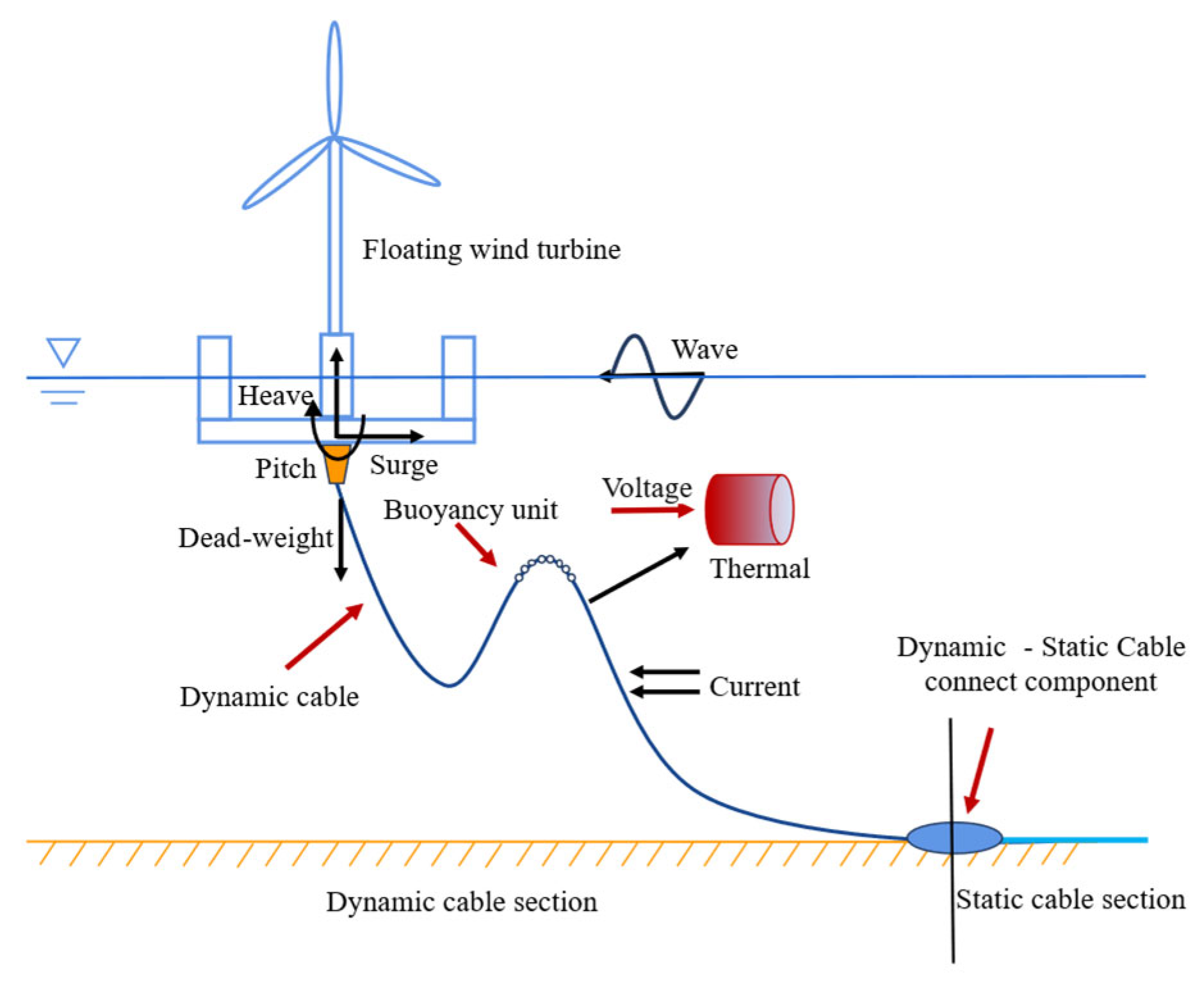
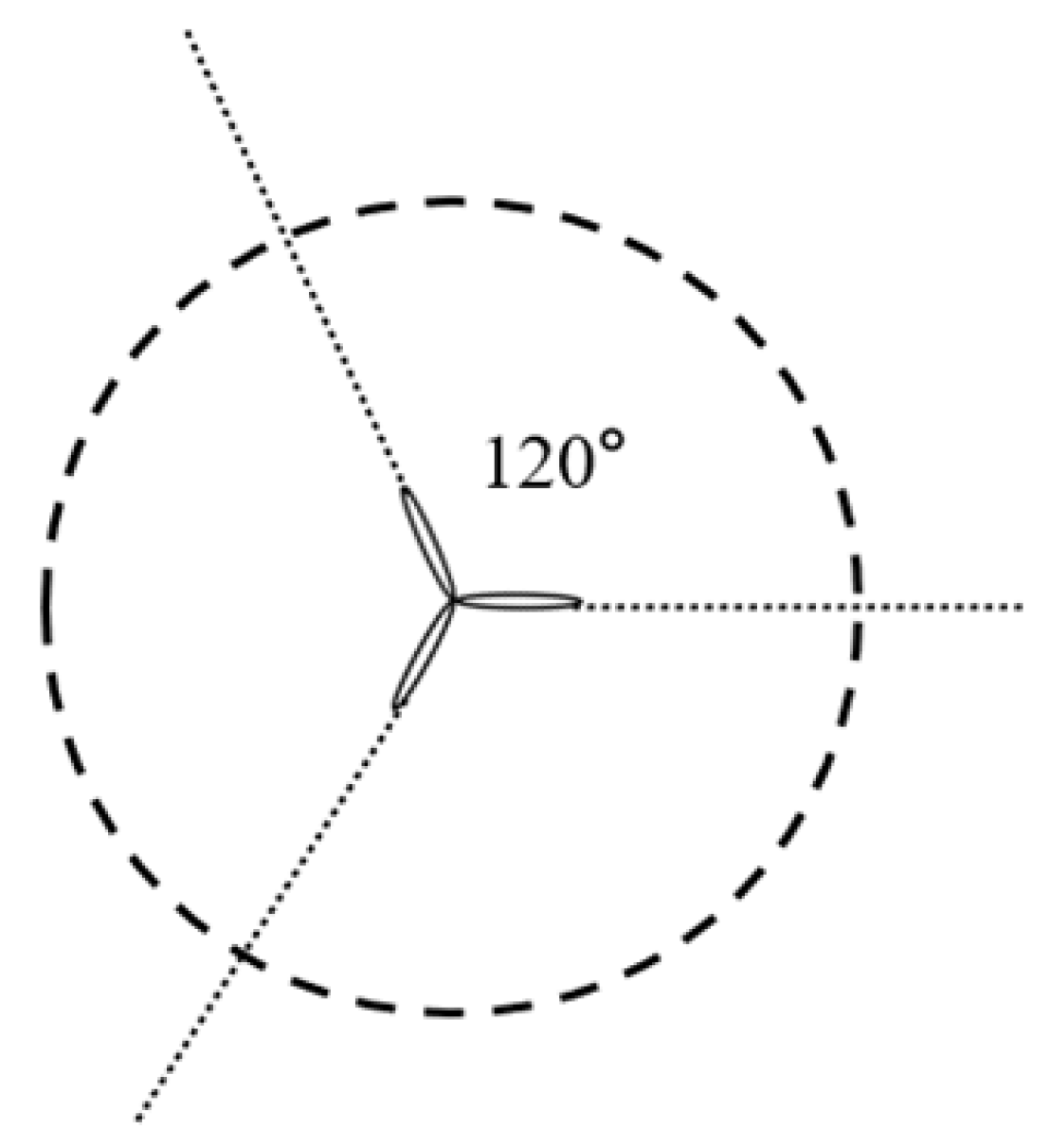


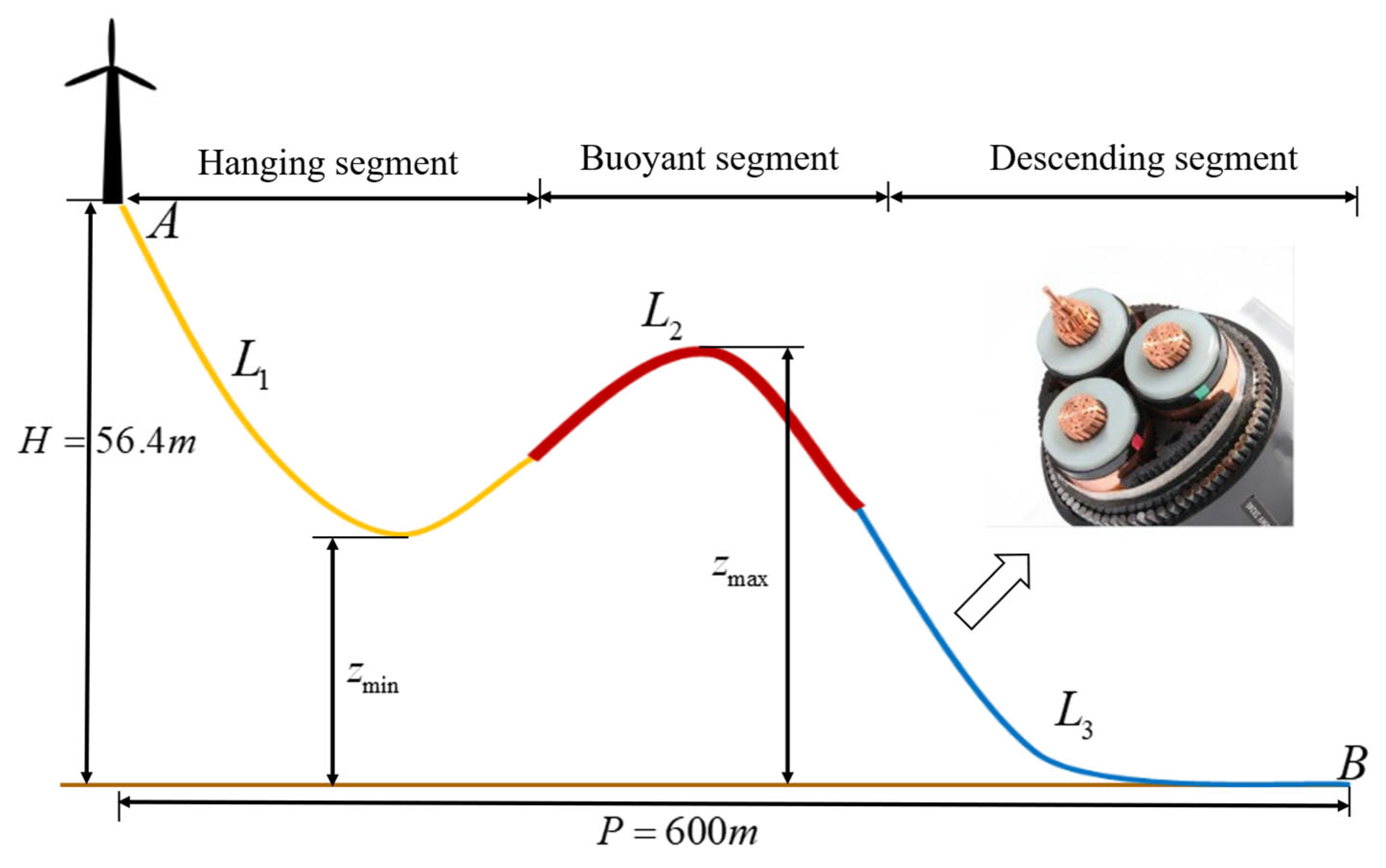
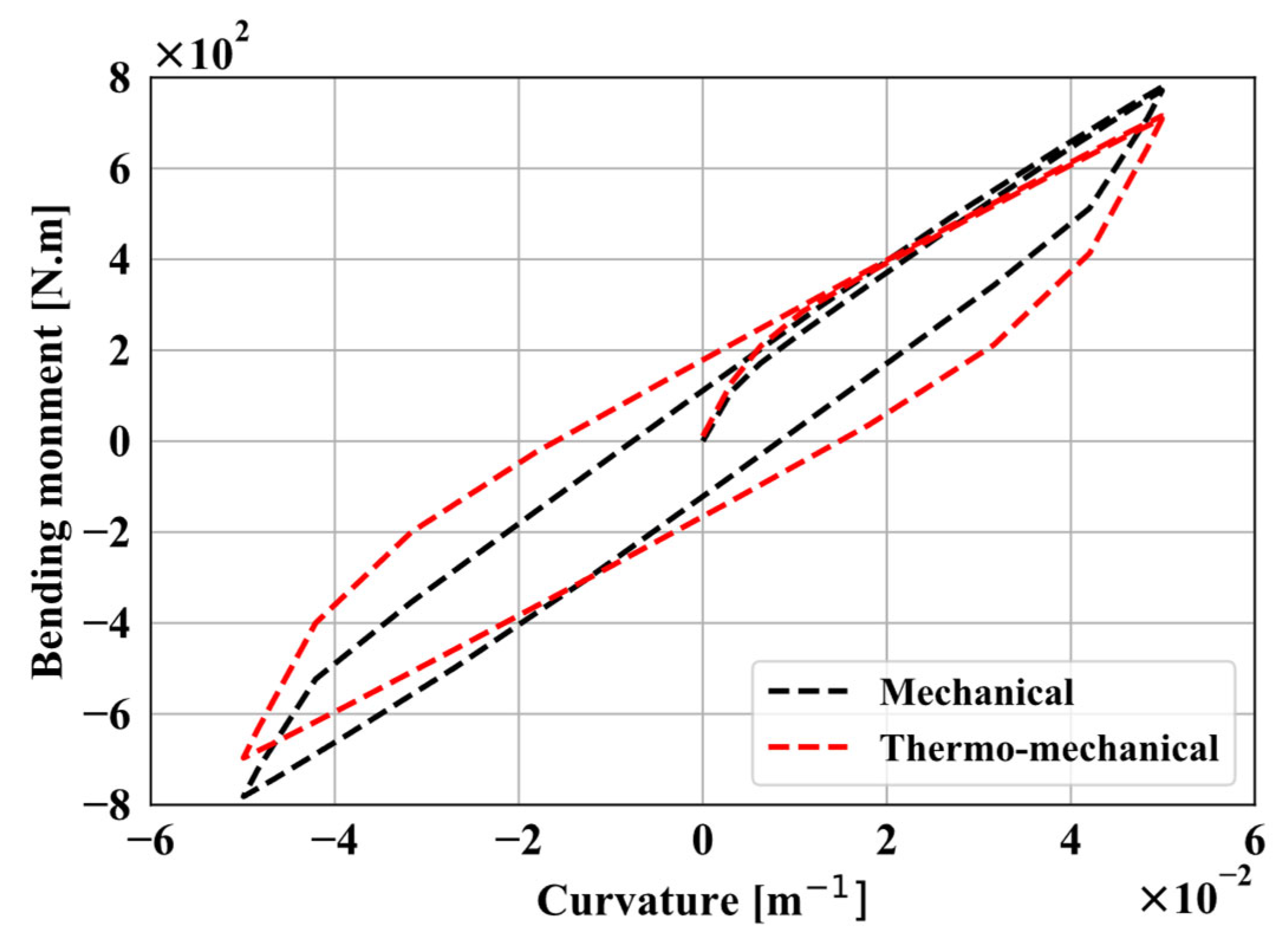
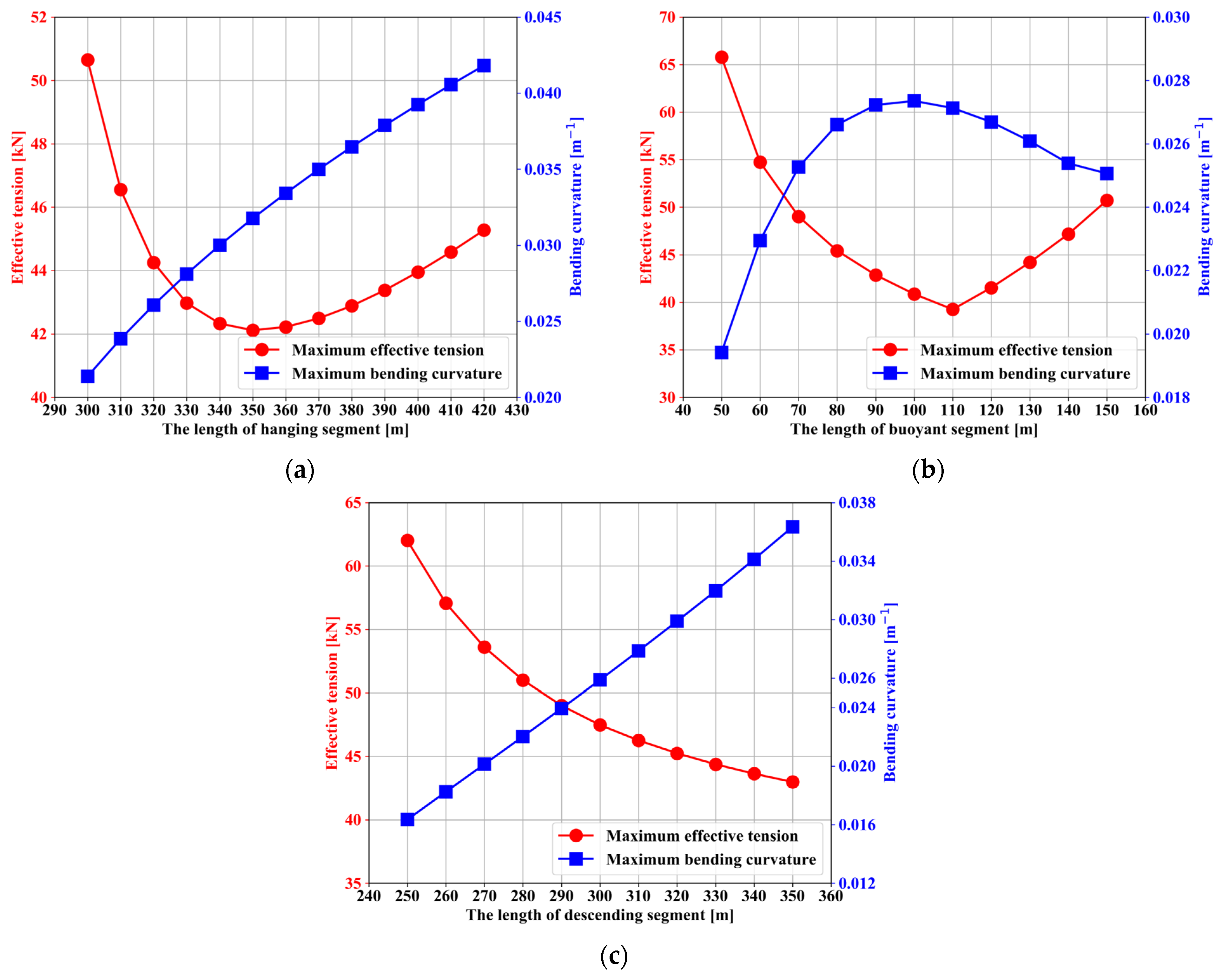
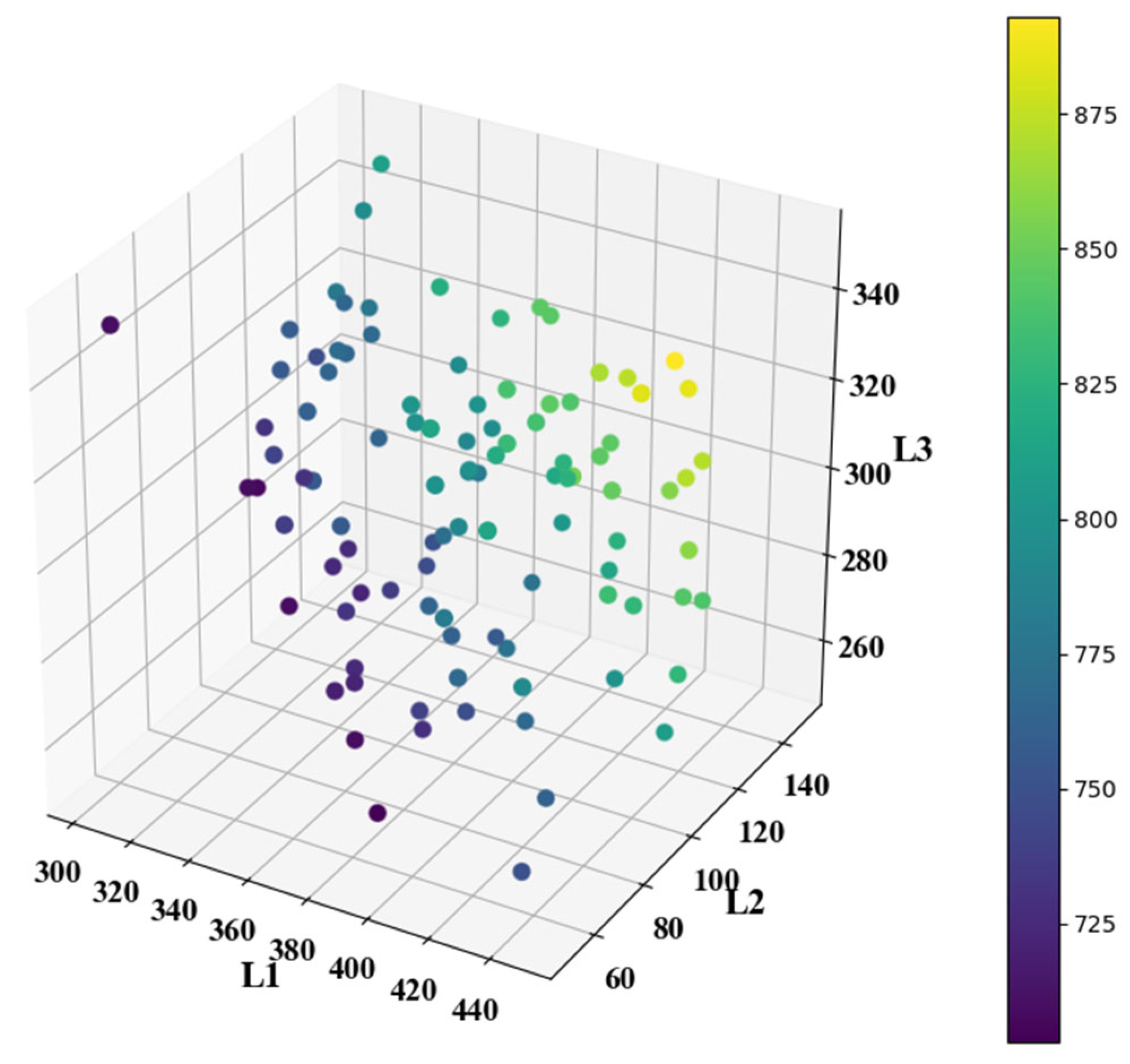


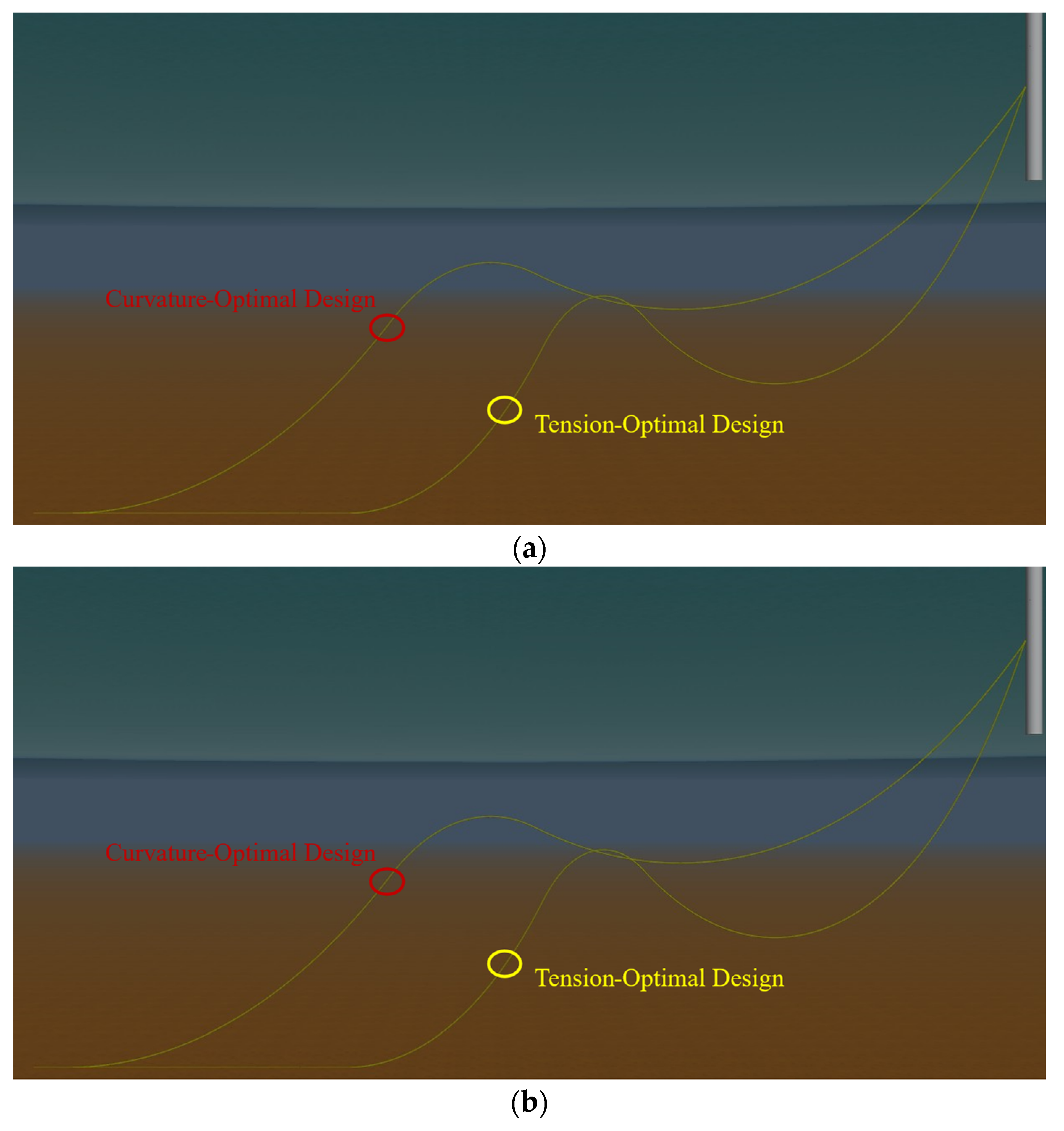


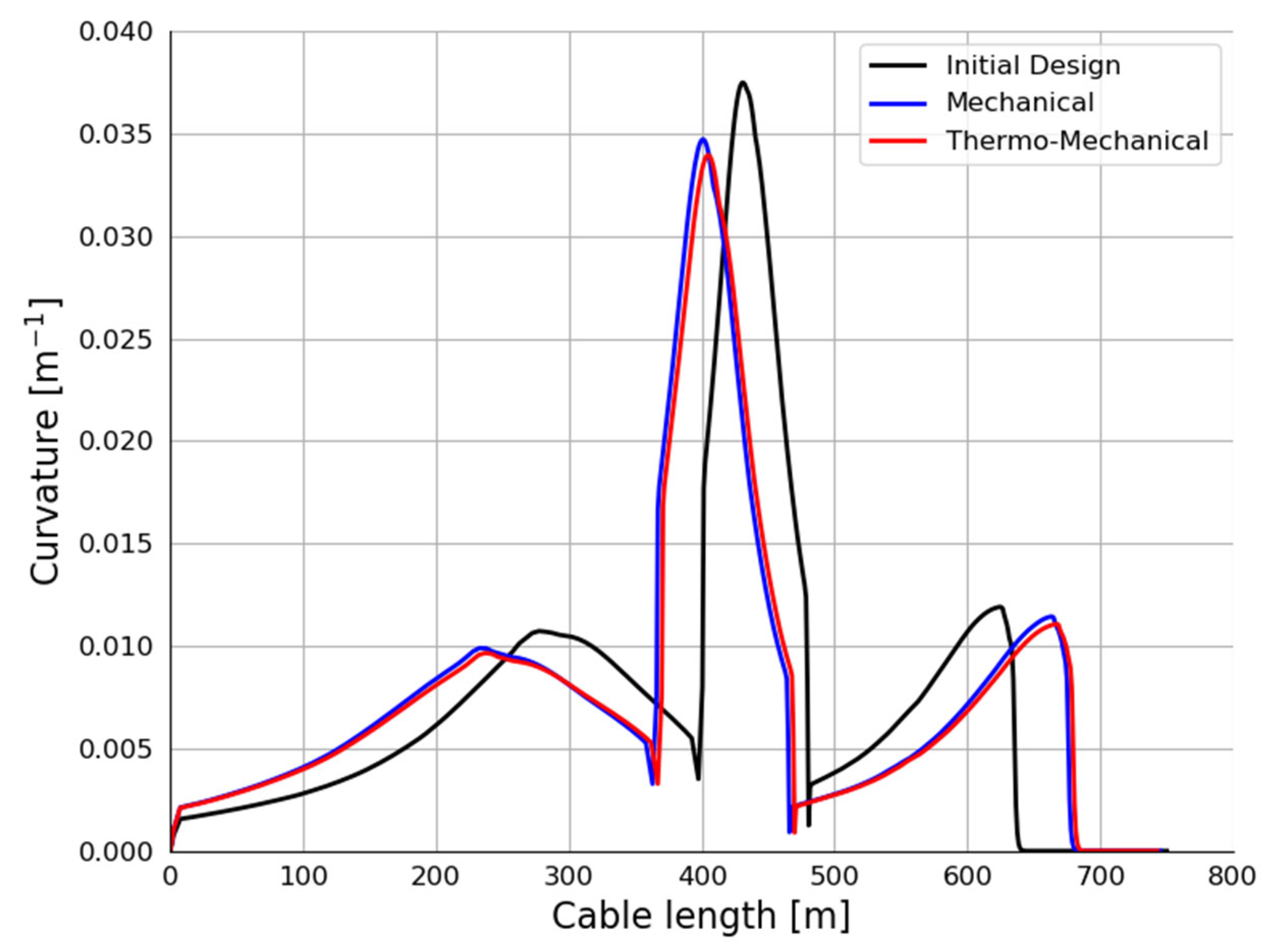
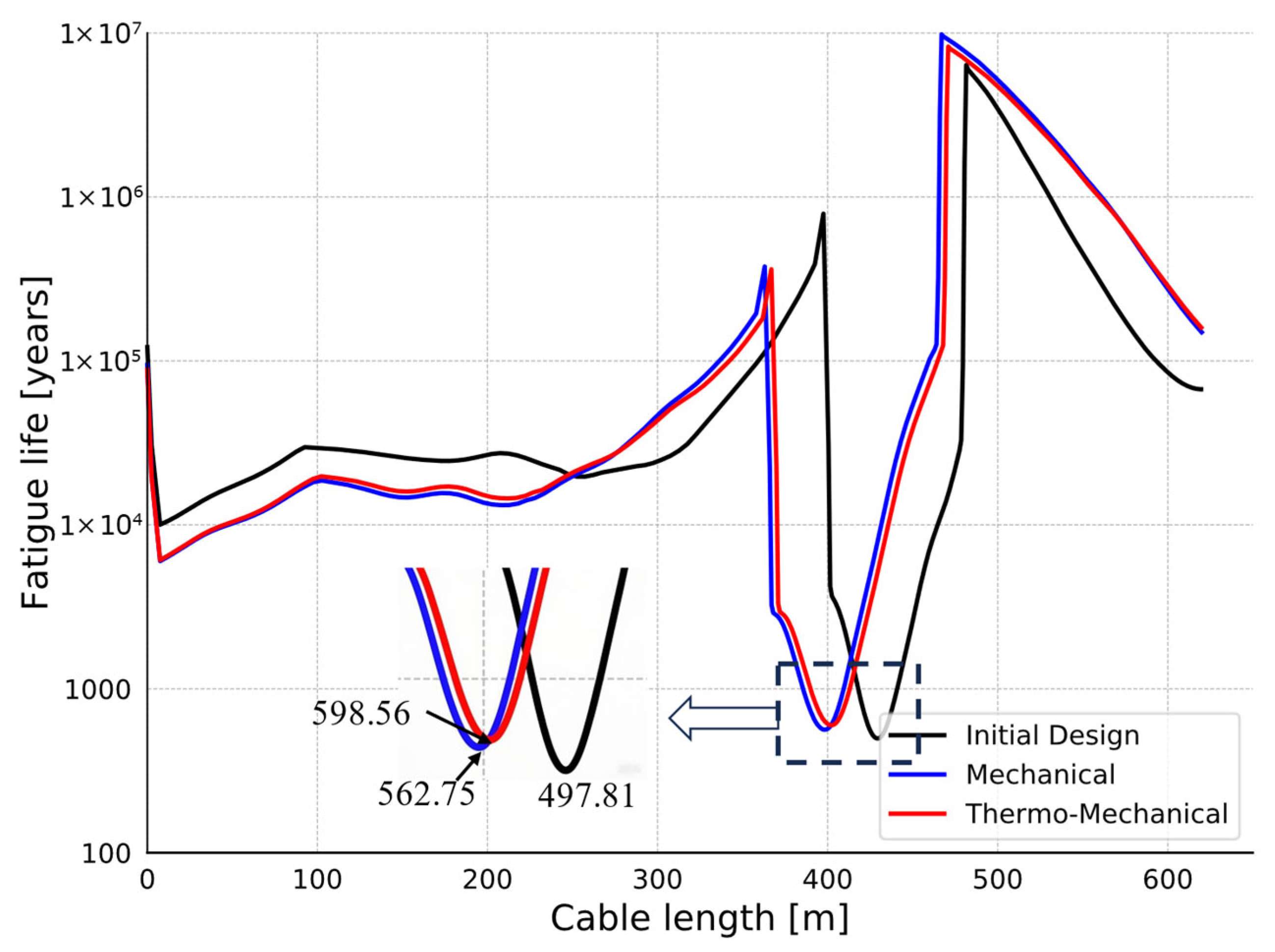
| Name | Parameters |
|---|---|
| Rated power | 5 MW |
| Rotor orientation, configuration | Upwind, 3 blades |
| Rotor, hub diameter | 126, 3 m |
| Hub height | 90 m |
| Cut-in, rated, cut-out speed | 3, 11.4, 25 m/s |
| Cut-in, rated rotor speed | 6.9 rpm, 12.1 rpm |
| Rotor mass | 110,000 kg |
| Nacelle mass | 240,000 kg |
| Tower mass | 347,460 kg |
| Name | Wind Speed [m/s] | Wave Height [m] | Period [s] | Current at Surface [m/s] | Turbine Status |
|---|---|---|---|---|---|
| Rated loads | 11.4 | 6.0 | 10.0 | 0.486 | Operating |
| Extreme loads | 29.0 | 13.2 | 15.1 | 1.070 | Shutdown |
| Name | Parameter | |
|---|---|---|
| Mechanical Analysis | Thermo-Mechanical Coupling Analysis | |
| Outer diameter | 0.116 m | |
| Weight in air | 25.0 kg/m | |
| Axial stiffness | 345.0 MN | 233.0 MN |
| Nonlinear bending stiffness | ||
| Tension at conductor yield | 885 kN | |
| Maximum bending curvature | 0.555 m−1 | |
| Drag coefficient (normal, axial) | 1.2, 0.008 | |
| Added mass coefficient (normal, axial) | 1.0, 0.0 | |
| Name | Parameter | |
|---|---|---|
| Mechanical Analysis | Thermo-Mechanical Coupling Analysis | |
| Outer diameter | 0.361 m | |
| Weight in air | 59.0 kg/m | |
| Axial stiffness | 345.0 MN | Axial stiffness |
| Nonlinear bending stiffness | Nonlinear bending stiffness | |
| Drag coefficient (normal, axial) | 2.617, 0.345 | |
| Added mass coefficient (normal, axial) | 1.0, 0.469 | |
| Analysis Methods | Maximum Effective Tension | Maximum Bending Curvature | > 0.95 |
|---|---|---|---|
| Error () | Error () | ||
| Mechanical Analysis | 0.969 | 0.994 | Yes |
| Thermo-Mechanical Coupling Analysis | 0.968 | 0.995 | Yes |
| Parameter | Population Size | Number of Generations | Crossover Probability | Mutation Probability |
|---|---|---|---|---|
| Value | 50 | 100 | 0.9 | 0.1 |
| Calculation Method | Tension Optimal Design | Curvature Optimal Design | ||
|---|---|---|---|---|
| Maximum Effective Tension/[kN] | Maximum Bending Curvature/[m−1] | Maximum Effective Tension/[kN] | Maximum Bending Curvature/[m−1] | |
| Surrogate model | 35.68 | 0.05049 | 80.73 | 0.02596 |
| Numerical simulation | 38.02 | 0.05124 | 82.24 | 0.02729 |
| Error/% | 6.15% | 0.29% | 1.84% | 4.87% |
| Calculation Method | Tension Optimal Design | Curvature Optimal Design | ||
|---|---|---|---|---|
| Maximum Effective Tension/[kN] | Maximum Bending Curvature/[m−1] | Maximum Effective Tension/[kN] | Maximum Bending Curvature/[m−1] | |
| Surrogate model | 37.85 | 0.04939 | 80.98 | 0.02756 |
| Numerical simulation | 40.27 | 0.04976 | 82.71 | 0.02833 |
| Error/% | 6.01% | 0.07% | 2.09% | 2.72% |
| Comparison of Design Schemes | Optimization Objective | Global Configuration Parameters | |||
|---|---|---|---|---|---|
| Maximum Effective Tension/[kN] | Hanging Segment/[m] | Buoyant Segment/[m] | Descending Segment/[m] | Total Length/[m] | |
| Initial design | 54.44 | 400.0 | 80.0 | 270.0 | 750.0 |
| Mechanical analysis | 51.88 | 365.5 | 100.4 | 279.8 | 745.7 |
| Change rate | −4.93% | - | - | - | −0.57% |
| Thermo-mechanical coupling analysis | 53.03 | 369.4 | 99.8 | 273.5 | 742.7 |
| Change rate | −2.59% | - | - | - | −0.97% |
| Comparison of Design Schemes | Optimization Objective | Global Configuration Parameters | |||
|---|---|---|---|---|---|
| Maximum Bending Curvature/[m−1] | Hanging Segment/[m] | Buoyant Segment/[m] | Descending Segment/[m] | Total Length/[m] | |
| Initial design | 0.03747 | 400.0 | 80.0 | 270.0 | 750.0 |
| Mechanical analysis | 0.03470 | 365.5 | 100.4 | 279.8 | 745.7 |
| Change rate | −7.39% | - | - | - | −0.57% |
| Thermo-mechanical coupling analysis | 0.03394 | 369.4 | 99.8 | 273.5 | 742.7 |
| Change rate | −9.42% | - | - | - | −0.97% |
Disclaimer/Publisher’s Note: The statements, opinions and data contained in all publications are solely those of the individual author(s) and contributor(s) and not of MDPI and/or the editor(s). MDPI and/or the editor(s) disclaim responsibility for any injury to people or property resulting from any ideas, methods, instructions or products referred to in the content. |
© 2025 by the authors. Licensee MDPI, Basel, Switzerland. This article is an open access article distributed under the terms and conditions of the Creative Commons Attribution (CC BY) license (https://creativecommons.org/licenses/by/4.0/).
Share and Cite
Li, Y.; Zou, G.; Yang, S.; Qiao, D.; Wang, B. Optimization Design of Dynamic Cable Configuration Considering Thermo-Mechanical Coupling Effects. J. Mar. Sci. Eng. 2025, 13, 1336. https://doi.org/10.3390/jmse13071336
Li Y, Zou G, Yang S, Qiao D, Wang B. Optimization Design of Dynamic Cable Configuration Considering Thermo-Mechanical Coupling Effects. Journal of Marine Science and Engineering. 2025; 13(7):1336. https://doi.org/10.3390/jmse13071336
Chicago/Turabian StyleLi, Ying, Guanggen Zou, Suchun Yang, Dongsheng Qiao, and Bin Wang. 2025. "Optimization Design of Dynamic Cable Configuration Considering Thermo-Mechanical Coupling Effects" Journal of Marine Science and Engineering 13, no. 7: 1336. https://doi.org/10.3390/jmse13071336
APA StyleLi, Y., Zou, G., Yang, S., Qiao, D., & Wang, B. (2025). Optimization Design of Dynamic Cable Configuration Considering Thermo-Mechanical Coupling Effects. Journal of Marine Science and Engineering, 13(7), 1336. https://doi.org/10.3390/jmse13071336







